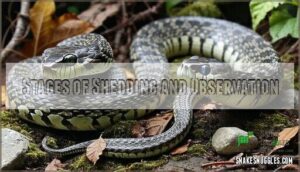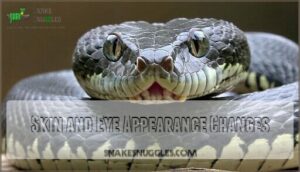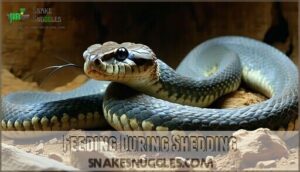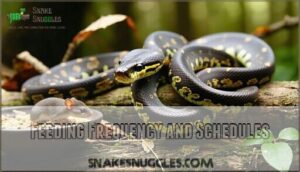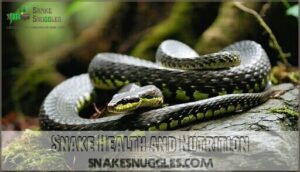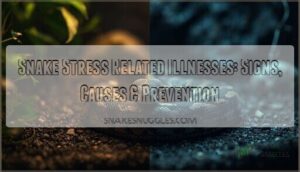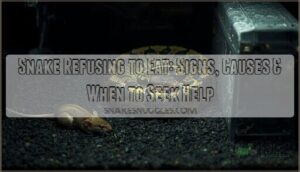This site is supported by our readers. We may earn a commission, at no cost to you, if you purchase through links.
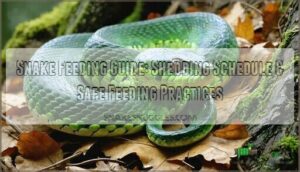 Your snake feeding guide shedding schedule should pause during the shed cycle.
Your snake feeding guide shedding schedule should pause during the shed cycle.
Don’t offer food when your snake’s eyes turn milky or skin looks dull—they can’t see properly and won’t eat anyway.
Most snakes refuse meals during shedding, so you’re just wasting prey items.
Wait until the old skin peels off completely, then resume your regular feeding routine.
This approach prevents stress and lets your snake focus energy on shedding rather than digestion.
The timing varies by species, but patience pays off.
Smart feeding schedules consider natural behaviors, and there’s more to timing than just counting days between meals.
This is because understanding and working with your snake’s shedding cycle is crucial for their health.
Table Of Contents
- Key Takeaways
- Snake Feeding Basics
- Feeding Practices and Safety
- Snake Shedding Cycle
- Feeding During Shedding
- Feeding Frequency and Schedules
- Snake Health and Nutrition
- Erratic Feeding and Variety
- Advanced Feeding Topics
- Frequently Asked Questions (FAQs)
- Should you feed a snake when it is shedding?
- When should I change my snakes feeding schedule?
- What is the best time of day to feed snakes?
- How often should an adult corn snake feed?
- Can snakes eat fish or aquatic prey?
- How to transition picky eaters to food?
- What temperature should frozen prey be thawed?
- Do snakes need water bowls during feeding?
- How long after shedding before feeding?
- Conclusion
Key Takeaways
- Don’t feed during shedding cycles – Skip meals when your snake’s eyes turn milky or skin looks dull, as they can’t see properly and will likely refuse food anyway
- Wait for complete shed before resuming feeding – Give your snake 24-48 hours after they’ve finished shedding to recover from stress before offering their next meal
- Understand shedding affects appetite naturally – Most snakes refuse food during the 10-14 day shedding process, so you’re not wasting prey items by waiting
- Monitor individual shedding patterns – Learn your snake’s specific shedding cycle timing to adjust your feeding schedule and prevent unnecessary stress or regurgitation
Snake Feeding Basics
Feeding your snake properly starts with understanding what they eat and how often they need meals.
You’ll want to choose the right prey size, decide between pre-killed and live options, and establish a feeding schedule that keeps your snake healthy without overfeeding.
Prey Selection and Nutrition
When choosing prey for your snake, nutritional completeness matters most.
Captive-bred prey like frozen rodents offers safer, more consistent nutrition than wild prey.
Prey variety prevents deficiencies—rotate between mice, rats, and chicks rather than feeding one type exclusively.
Always match prey size to your snake’s widest body part for ideal digestion and health.
Snakes also require essential nutrients like calcium for bone health.
Whole Prey Vs Live Prey
In the context of snake feeding, dead prey beats live prey hands down.
Whole prey offers complete nutritional value with muscle, bone, and organs your snake needs.
Live prey creates serious injury risks from bites and scratches, plus ethical concerns about animal suffering.
Frozen or pre-killed options eliminate parasite transmission while providing the same nutritional completeness, making them the safer choice for responsible snake care.
Some keepers find that live feeding allows snakes to exhibit natural hunting behaviors, which is an important aspect of snake care and understanding natural behaviors.
Feeding Frequency and Portion Sizes
Your snake’s feeding frequency depends on its age and size.
Juvenile snakes need food every 5-7 days for rapid growth, while adults eat every 1-4 weeks depending on species.
Monitor your snake’s weight regularly to prevent overfeeding risks that lead to obesity.
Seasonal appetite changes are normal, especially during shedding or breeding periods.
Adult portions should match 10-15% of body weight, which is a key factor in maintaining a healthy snake, and preventing risks associated with rapid growth.
Feeding Practices and Safety
Safe feeding practices protect both you and your snake from unnecessary harm. You’ll want to use pre-killed prey and proper handling techniques to create a stress-free feeding environment.
Handling Pre-Killed Prey
Pre-killed prey offers the safest feeding option for your snake.
**Pre-killed prey eliminates injury risks while delivering complete nutrition your snake needs.
Proper thawing techniques and warming methods guarantee your snake accepts frozen prey readily. Here’s your essential snake feeding guide for handling prekilled prey:
- Thawing: Move frozen prey from freezer to refrigerator overnight, then warm in sealed bag submerged in warm water
- Storage Guidelines: Keep rodent feeders frozen up to six months, thawed prey refrigerated maximum 48 hours
- Scent Enhancement: Gently warming frozenthawed prey releases natural scents that trigger feeding responses
Safe handling prevents contamination while proper preparation mimics live prey temperatures.
Reducing Stress and Injury Risk
Smart snake owners know that stress kills appetite and invites disaster.
Feed your snake inside its regular enclosure to avoid unnecessary handling stress. Use separate feeding tanks only when housing multiple snakes together, as this prevents food competition and territorial disputes.
Monitor your snake’s feeding response carefully—sluggish reactions often signal underlying health issues. Safe prey handling means keeping pre-killed food at proper temperatures and never leaving uneaten meals in the habitat.
To guarantee healthy results, always follow safe snake feeding practices.
Using Tongs for Feeding
Feeding tools matter more than you might think. Tongs prevent your hands from carrying food scent that triggers defensive strikes. Long feeding tongs keep a safe distance while maintaining grip strength for secure food placement. This hygienic feeding method reduces bites and snake feeding challenges substantially.
You can find suitable snake feeding equipment online.
- Choose 12-inch tongs – Provides safe distance from striking range during feeding sessions
- Grip prey firmly – Secure hold prevents dropped food and reduces snake feeding precautions needed
- Drop, don’t dangle – Place food directly in enclosure rather than waving it around
- Clean between uses – Prevents bacteria buildup and maintains proper snake feeding safety standards
Snake Shedding Cycle
Understanding your snake’s shedding cycle helps you make better feeding decisions and keep your pet healthy.
You’ll notice clear physical changes during the 10-14 day process that signal when to adjust care routines, which is a complete concept to consider for the well-being of your pet.
Stages of Shedding and Observation
Recognizing snake shedding signs helps you adjust care routines effectively.
Initial signs include dull skin and cloudy eyes that gradually worsen.
During the opaque stage, eyes turn completely blue and vision becomes impaired.
The clearing up phase shows eyes returning to normal while skin preparation continues.
Final shedding involves active skin sloughing through rubbing motions.
Shedding frequency varies by age and species, with juveniles molting more often than adults.
Environmental Considerations and Humidity
Creating the right environment helps your snake shed successfully. Humidity levels should stay between 50-60% normally, rising to 70-80% during shedding. Temperature gradients matter too – maintain proper warm and cool zones.
Water availability becomes critical, so provide a larger water bowl. Your substrate choice affects moisture retention substantially.
Snakes undergo a process called ecdysis to shed their skin.
- Boost humidity gradually when you notice early shedding signs to prevent stuck shed
- Check temperature gradients daily to confirm your snake can thermoregulate properly during this vulnerable time
- Upgrade water bowl size temporarily to increase ambient moisture and drinking opportunities
- Monitor substrate moisture without creating soggy conditions that promote bacterial growth
Skin and Eye Appearance Changes
Your snake’s appearance will change dramatically during shedding.
Dull skin replaces the normal shine, and you might notice a pink belly on some species.
The most obvious sign is opaque eyes that turn blue or gray, creating that distinctive "in-blue" appearance.
During the clearing stage, eyes become transparent again while skin remains slightly dull, signaling the final shed approaches.
Feeding During Shedding
You shouldn’t feed your snake during the shedding process, especially during the opaque "in-blue" stage when their vision is impaired and stress levels are high.
Wait until your snake has completely finished shedding before resuming their regular feeding schedule to avoid potential regurgitation or defensive strikes.
Should You Feed a Shedding Snake
Most experts don’t recommend feeding during shedding stages due to stress considerations and digestion impact on snake behavior. Individual variation exists, but shedding appetite typically decreases as snakes focus energy on the molting process rather than food.
Looking at the paragraph about feeding during shedding stages, here’s a short blockquote that captures the same tone and key message:
Skip meals during shedding—your snake’s focused on molting, not munching.
- Avoid feeding during opaque "in-blue" stage – Vision impairment increases defensive striking
- Skip meals 2-3 days before expected shed – Prevents regurgitation from handling stress
- Wait until complete shed occurs – Fresh skin indicates normal appetite return
- Monitor individual snake patterns – Some snakes maintain feeding interest throughout shedding
Adjusting Feeding Schedules and Frequency
Adjusting your snake’s feeding schedule during shedding requires flexibility.
Young snakes may skip one feeding, while adults can go weeks without eating.
Growth stage and individual variation affect timing—some snakes maintain appetite throughout seasonal changes, others refuse food completely.
Environmental impact on snake metabolism means temperature fluctuations alter feeding frequency.
Breeding considerations also influence snake appetite patterns during this vulnerable period.
Remember that the optimal feeding schedule depends on species.
Monitoring Snake Health and Behavior
Keeping an eye on your snake during shedding helps you spot problems early.
Watch for changes in normal patterns and behaviors that signal health concerns.
Here’s what to monitor:
- Behavioral Changes – Watch for unusual hiding, aggression, or lethargy beyond typical shedding behavior
- Shedding Issues – Look for stuck shed pieces, incomplete sheds, or repeated shedding problems
- Weight Fluctuations – Track sudden weight loss or gain using regular weigh-ins
- Hydration Levels – Check for wrinkled skin, sunken eyes, or skin tenting when gently pinched
- Fecal Analysis – Monitor bowel movements for parasites, blood, or unusual consistency
Regular animal observation helps you understand your snake’s normal patterns and catch health issues before they become serious problems.
Feeding Frequency and Schedules
Getting your snake’s feeding schedule right makes all the difference between a healthy, thriving pet and one that struggles with weight or health issues.
You’ll need to adjust how often you feed based on your snake’s age, species, and size, since a juvenile ball python has very different needs than an adult boa constrictor, and getting this balance right is crucial for a healthy pet.
Adult Snake Feeding Intervals
Adult snakes need consistent feeding schedules based on their Metabolic Rate and Activity Levels.
Your snake’s Individual Needs vary with size and species, requiring careful obesity prevention through proper intervals.
| Species | Feeding Interval | Prey Size | Notes |
|---|---|---|---|
| Ball Python | 1-2 weeks | 10-15% body weight | Seasonal Variation affects appetite |
| Corn Snake | 7-10 days | 2 small mice | Adjust for activity levels |
| Boa Constrictor | 2-4 weeks | 1 large mouse/rat | Monitor for overfeeding |
| Burmese Python | 2-3 weeks | 5-pound rabbit | Requires larger prey items |
Juvenile Snake Feeding Requirements
Young snakes are growing machines that need consistent fuel. Their rapid development demands more frequent meals than their adult counterparts, typically every 5-7 days regardless of species.
Consider these juvenile snake feeding essentials:
- Growth Stage Nutrition requires smaller prey items sized appropriately for their developing bodies
- Small Prey Variety helps establish healthy eating habits while preventing nutritional deficiencies
- Frequent Feeding Dangers include overfeeding, which can reduce snake health and lifespan
- Hydration Importance becomes critical during active growth periods for proper snake diet success
Species-Specific Feeding Recommendations
Different snake species have unique feeding schedules you’ll want to master.
Ball pythons eat every 10-21 days as adults, while corn snakes need food every 10-14 days.
Boa constrictors follow similar patterns but can extend to monthly feedings when mature.
Garter snakes require more frequent meals every 7-10 days due to their faster metabolism.
Burmese pythons, being giants, consume large prey every 2-3 weeks once established, and have a distinct feeding pattern compared to other species like the ball pythons.
Snake Health and Nutrition
Your snake’s health depends on understanding the connection between proper nutrition and appetite changes.
Recognizing early signs of illness, dehydration, or malnutrition can prevent serious health problems and keep your pet thriving, which is crucial for maintaining your pet’s overall health.
Anorexia and Appetite Loss Causes
When your snake suddenly stops eating, don’t panic—anorexia happens for many reasons.
Stress-induced anorexia from poor temperatures or handling tops the list. Environmental appetite loss stems from wrong humidity, lighting, or substrates.
Parasitic infections, kidney failure, and cancer symptoms require immediate reptile feeding veterinary care.
Watch for mouth rot, respiratory issues, or shedding cycles causing temporary snake appetite loss, which may also be triggered by stress-induced factors or environmental changes.
Recognizing Dehydration and Malnutrition
Regular weight monitoring helps you spot trouble before it becomes serious.
Healthy snakes maintain consistent body weight, while dehydrated snakes show loose, wrinkled skin around their neck area.
Environmental factors like improper humidity can worsen these conditions.
Watch for these warning signs:
- Skin Tautness – Loose, wrinkled skin indicates dehydration
- Weight Loss – Gradual weight reduction signals nutritional problems
- Shedding Irregularities – Incomplete sheds suggest hydration issues
Proper snake nutrition requires attention to both snake feeding schedules and snake hydration needs.
Regular Monitoring and Veterinary Care
Most snake owners benefit from monthly veterinary checks during the first year to establish baseline health screens.
These snake wellness visits help catch problems early. Regular weighing tracks growth patterns and detects sudden weight loss that signals illness.
| Monitoring Schedule | What to Check | When to Act |
|---|---|---|
| Weekly weighing | Body weight changes | 10% weight loss |
| Monthly visual exam | Skin, eyes, behavior | Persistent changes |
| Annual vet visit | Complete health screen | Preventive care |
Professional reptile veterinarians can recommend medical interventions when your snake’s feeding patterns change unexpectedly.
They’ll help you adjust your reptile shedding schedule and identify snake shedding signs that indicate health issues beyond normal ecdysis.
Erratic Feeding and Variety
Varying your snake’s feeding schedule mimics natural hunting patterns and keeps their feeding response sharp.
You’ll want to offer different prey types like mice, rats, and chicks to provide complete nutrition while preventing your snake from becoming too picky about food.
Benefits of Erratic Feeding Patterns
Erratic feeding mimics your snake’s natural hunting behavior in the wild, where meals aren’t guaranteed daily.
This feeding variety stimulates natural hunger responses and prevents your pet from becoming too predictable with food expectations.
Random feeding cycles enhance your snake’s feeding response while supporting healthy prey rotation.
Irregular schedules help maintain strong hunting instincts throughout their lifetime.
Offering a Variety of Prey Items
Rotating prey items keeps your snake healthy and engaged.
Mice, rats, chicks, and quail offer different nutrients that support strong immune function and prevent deficiencies.
Food rotation also prevents your snake from becoming picky about one prey type.
This feeding diversity mimics wild hunting patterns, ensuring balanced snake nutrition while maintaining prey size guidelines for safe digestion and peak health, which supports strong immune function.
Encouraging Natural Hunting Behavior
Mimicking wild conditions helps your snake’s hunting instinct thrive.
Present prey variety using different angles and movements with feeding tongs to trigger natural foraging responses.
This stimulus feeding approach keeps your pet mentally engaged while supporting proper reptile nutrition.
Your snake feeding guide should include these presentation techniques alongside your regular shedding schedule monitoring.
Advanced Feeding Topics
As you master basic feeding routines, advanced techniques become essential for maintaining your snake’s peak health and natural behaviors.
These specialized approaches address nutrition supplementation, enclosure choices, and weight management that experienced keepers use to guarantee their snakes thrive long-term, utilizing complete concepts to ensure the best care.
Vitamin Supplements and Nutrition
Most snakes thrive on whole prey diets without extra vitamin supplements.
However, you’ll want to evaluate nutritional needs when your snake’s diet lacks variety. Here’s when vitamin supplements matter:
- Nutrient Balance – Indoor snakes may need calcium with D3
- Vitamin Needs – Fish-eating species require thiamine supplementation
- Mineral Supplements – Gut-load prey with quality products
- Dietary Additives – Use ReptiCal or Repashy brands
- Nutrition Research – Consult your vet for species-specific requirements
Reptile owners should research reptile supplement options to verify proper nutrition.
Feeding Outside The Enclosure Vs Inside
Feeding location affects your snake’s stress levels and safety.
Feeding inside the enclosure reduces handling stress and lets snakes feel secure in familiar territory.
Outside feeding prevents substrate ingestion but increases snake stress through handling and environmental changes.
Most experts recommend enclosure feeding for better snake safety and reduced feeding stress, especially during your snake’s shedding schedule.
Properly designed snake enclosure systems can help minimize these risks and create a safe environment for feeding.
Detecting Overeating and Weight Management
Watch for these red flags that signal overeating in your snake.
Visible fat rolls around the neck, a rounded body shape instead of triangular, and difficulty moving are classic obesity signs.
Adult snakes showing these symptoms need immediate feeding limits.
Healthy scales should feel firm, not squishy.
Monitor weight regularly using your snake feeding guide during normal periods, not during shedding schedule disruptions.
Proper weight management prevents serious health issues and extends your pet’s lifespan substantially.
Frequently Asked Questions (FAQs)
Should you feed a snake when it is shedding?
It’s like asking someone to eat a five-course meal while wearing a blindfold.
You shouldn’t feed your snake during shedding because they can’t see properly and feel stressed, making them likely to refuse food anyway.
When should I change my snakes feeding schedule?
Adjust your snake’s feeding schedule when it’s growing rapidly, approaching breeding season, showing signs of obesity, or refusing food for extended periods beyond normal intervals.
What is the best time of day to feed snakes?
Evening hours work best for feeding your snake.
Most species are naturally active at dusk or night, making them more likely to accept food during these times when their hunting instincts kick in.
How often should an adult corn snake feed?
Adult corn snakes eat like clockwork – every seven to ten days keeps them healthy and satisfied.
You’ll feed your snake two small mice weekly, maintaining this consistent schedule throughout their adult life.
Can snakes eat fish or aquatic prey?
Yes, snakes can eat fish and aquatic prey.
Many species naturally hunt fish, frogs, and other water-dwelling creatures in the wild, making aquatic options a nutritious addition to their captive diet.
How to transition picky eaters to food?
Try different prey types like chicks or quail instead of rodents.
Wiggle food with tongs to mimic movement.
Make certain proper temperatures and provide hiding spots to reduce stress during feeding attempts, especially to ensure proper care.
What temperature should frozen prey be thawed?
Thaw frozen prey to room temperature, around 70-75°F. You can use warm water to speed the process, but don’t use hot water or microwaves as they’ll cook the prey.
Do snakes need water bowls during feeding?
Water bowls aren’t essential during feeding, but they’re vital afterward. Snakes don’t drink while eating, yet they’ll need hydration for proper digestion and shedding cycles post-meal.
How long after shedding before feeding?
Wait 24-48 hours after your snake completes shedding before offering food.
This gives them time to recover from the stress and allows their digestive system to normalize after the shedding process.
Conclusion
Research shows that 70% of snake feeding problems stem from improper timing during shed cycles.
Your snake feeding guide shedding schedule becomes critical when you understand this natural process.
Don’t rush meals when your snake’s eyes cloud or skin dulls.
Wait until they’ve completely shed before resuming normal feeding.
This patience prevents stress and supports healthy digestion.
By respecting your snake’s natural rhythms, you’ll create a feeding routine that promotes long-term health and reduces feeding complications.
- https://www.merckvetmanual.com/management-and-nutrition/nutrition-exotic-and-zoo-animals/nutrition-in-snakes
- https://www.aquariumindustries.com.au/wp-content/uploads/2015/03/A-Guide-to-Feeding-Reptiles.pdf
- https://www.chewy.com/education/reptile-and-amphibian/snake/what-do-snakes-eat
- https://redinational.com/how-often-does-a-snake-shed-its-skin/
- https://forpetessnakes.ca/2021/05/06/the-snake-shedding-cycle/




